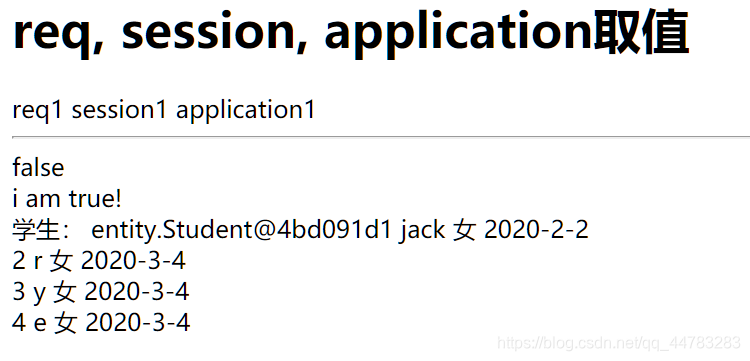el表达式的使用
- 学生类
public class Student {
int id;
String name;
String sex;
String birth;
public Student() {}
public Student(int id, String name, String sex, String birth) {
super();
this.id = id;
this.name = name;
this.sex = sex;
this.birth = birth;
}
// el 表达式取实体类的属性,需要设置get方法
public int getId(){
return id;
}
public String getName(){
return name;
}
public String getSex() {
return sex;
}
public String getBirth() {
return birth;
}
}
-
取域对象request,session,application的值
-
取学生对象的值
-
取集合对象的值
-
servlet doService方法如下
protected void service(HttpServletRequest req, HttpServletResponse resp)
throws ServletException, IOException {
// 请求编码
req.setCharacterEncoding("UTF-8");
// 响应编码
resp.setContentType("text/html;charset=UTF-8");
// 设置request, session, application域对象的值
req.setAttribute("req", "req1");
req.getSession().setAttribute("session", "session1");
req.getServletContext().setAttribute("app", "application1");
// 设置学生对象
req.setAttribute("stu", new Student(1, "jack", "男", "2020-2-2"));
// 设置集合对象
List<Student> list = new ArrayList<Student>();
list.add(new Student(2, "r", "女", "2020-3-4"));
list.add(new Student(3, "y", "女", "2020-3-4"));
list.add(new Student(4, "e", "女", "2020-3-4"));
req.setAttribute("list", list);
// 请求转发到index.jsp页面
req.getRequestDispatcher("index.jsp").forward(req, resp);
}
- jsp页面
<%@ page language="java" import="java.util.*" pageEncoding="UTF-8"%>
<%@ taglib uri="http://java.sun.com/jsp/jstl/core" prefix="c" %>
<%-- jsp/jstl/core --%>
<%
String path = request.getContextPath();
String basePath = request.getScheme()+"://"+request.getServerName()+":"+request.getServerPort()+path+"/";
%>
<!DOCTYPE HTML PUBLIC "-//W3C//DTD HTML 4.01 Transitional//EN">
<html>
<head>
<base href="<%=basePath%>">
<title>My JSP 'index.jsp' starting page</title>
<meta http-equiv="pragma" content="no-cache">
<meta http-equiv="cache-control" content="no-cache">
<meta http-equiv="expires" content="0">
<meta http-equiv="keywords" content="keyword1,keyword2,keyword3">
<meta http-equiv="description" content="This is my page">
</head>
<body>
<h1>req, session, application取值</h1>
<%-- 取域对象的值 --%>
${ req }
${ session }
${ app }
<hr/>
<%-- 判断空 --%>
${ empty 1 }
<c:if test="true">
<br/>i am true!
</c:if>
<br/>
学生:
${ stu } <%-- 学生对象 --%>
${ stu.name }
${ stu.sex }
${ stu.birth }
<br/>
<%-- 取list的值 --%>
<c:forEach items="${ list }" var="stu">
${ stu.id }
${ stu.name }
${ stu.sex }
${ stu.birth } <br/>
</c:forEach>
</body>
</html>

- 超链接参数取值
<a href="index.jsp?row_id=1">c标签取get</a>
// index.jsp页面 el表达式取值
${ param.row_id }

c标签的使用,取的别名c
- 导入jstl库,别导错了,还有一个标签库跟下面的很像。
<%@ taglib uri="http://java.sun.com/jsp/jstl/core" prefix="c" %>
<c:if test="${ 1==1 }">
1=1
</c:if>
<c:choose>
<c:when test="true">true</c:when>
<c:when test="false">false</c:when>
<c:otherwise>false</c:otherwise>
</c:choose>
<c:forEach begin="1" end="5" step="1" var="i">
${ i }
</c:forEach>





















 507
507











 被折叠的 条评论
为什么被折叠?
被折叠的 条评论
为什么被折叠?








